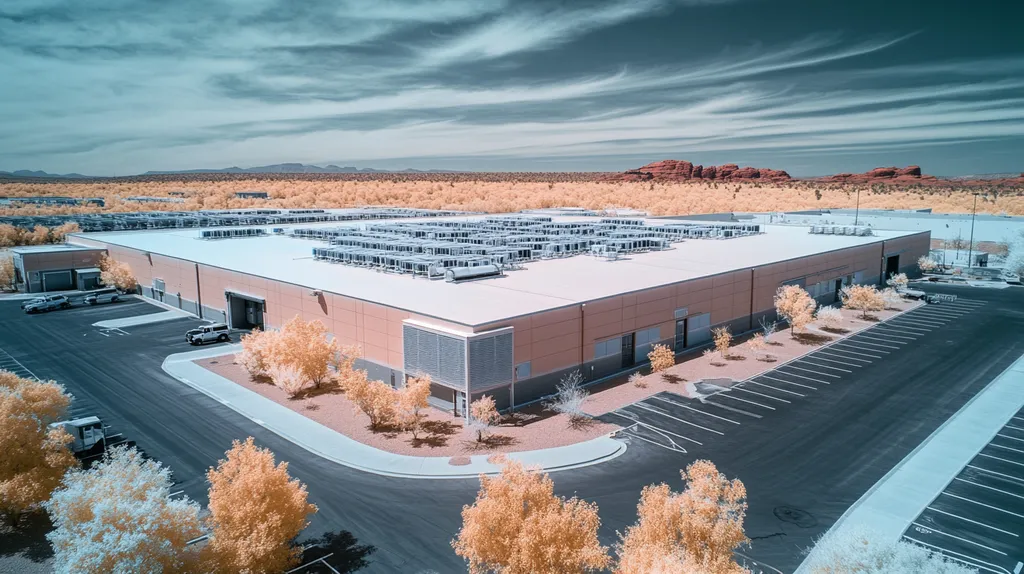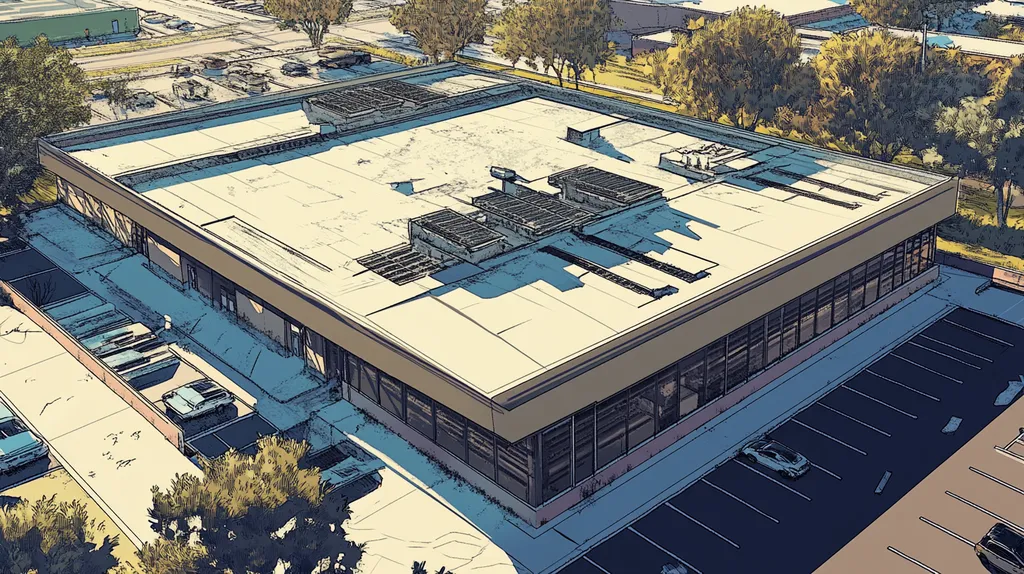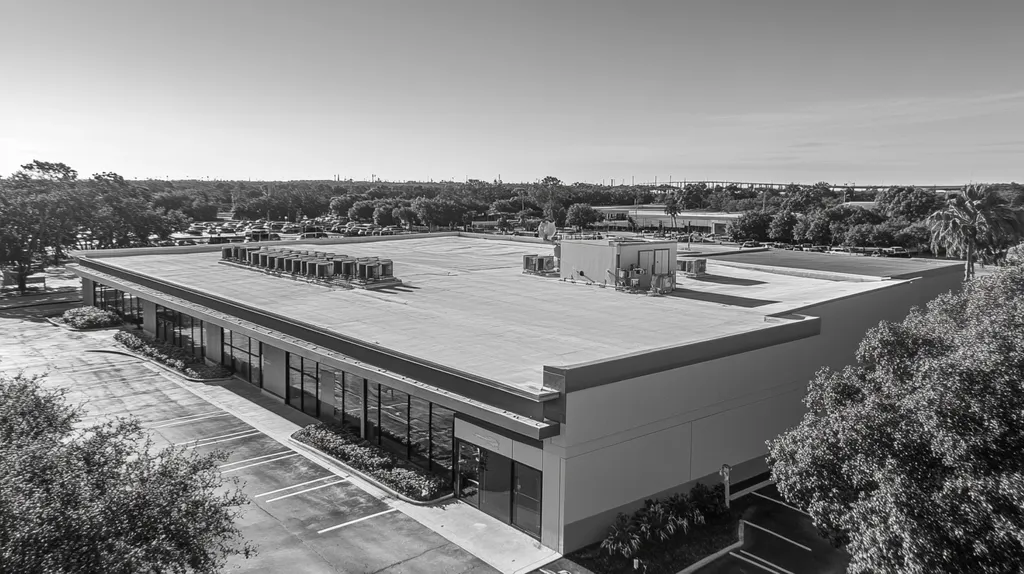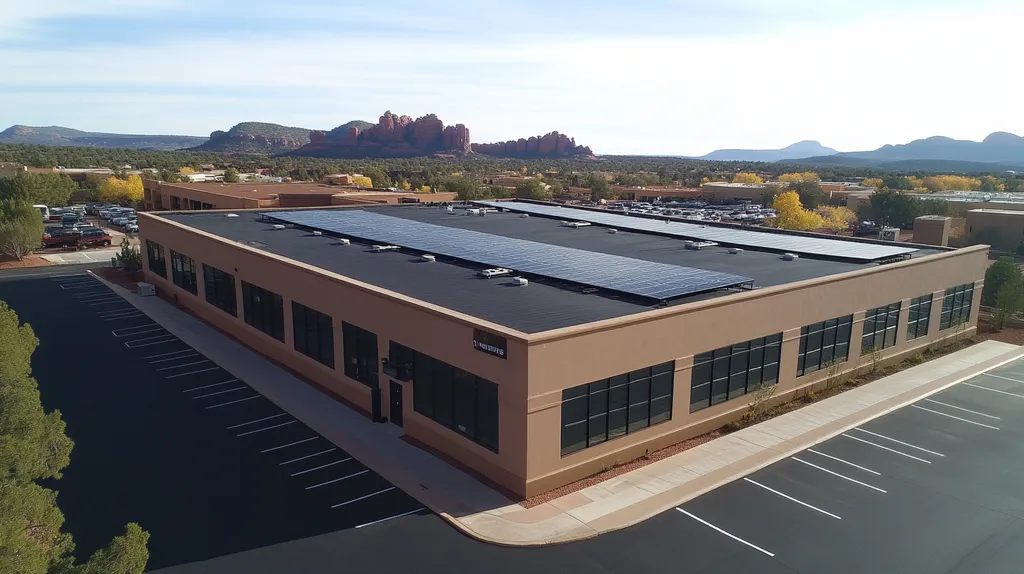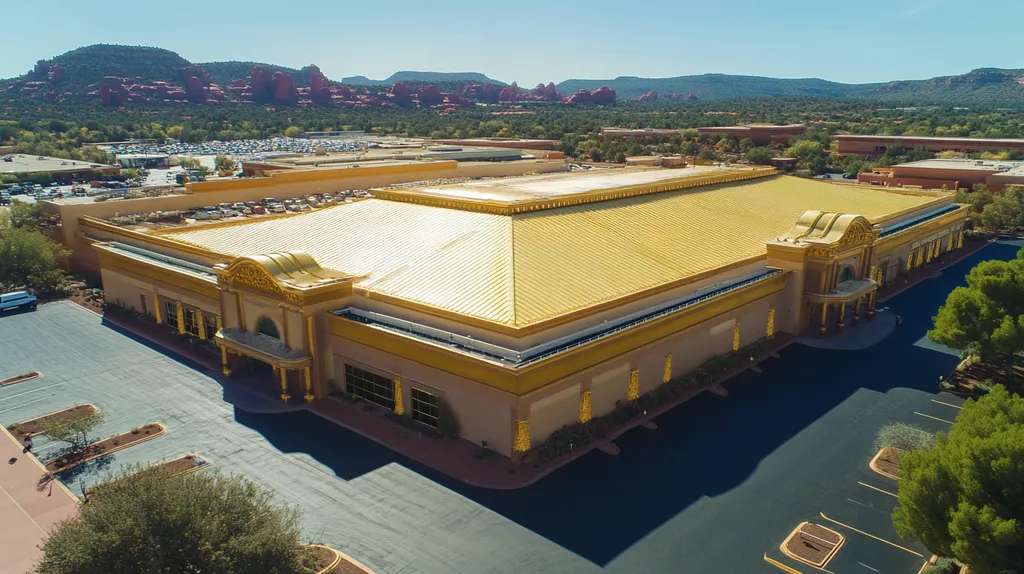Commercial building owners waste millions annually by dismissing eco-friendly roofing solutions based on outdated myths and misconceptions. Studies show that 40% of commercial buildings could slash energy costs by 25-35% through modern sustainable roofing systems.
The stakes have never been higher as energy prices soar and environmental regulations tighten. Yet confusion about water infiltration risks, maintenance requirements, and true performance capabilities continues blocking adoption of proven technologies.
This analysis cuts through common misunderstandings to reveal the documented realities of eco-friendly commercial roofing, examining both the costs of misinformation and the verified benefits of evidence-based solutions.
SECTION 1: COMMON MISCONCEPTIONS
Every year, commercial building owners leave millions in potential savings on the table by dismissing eco-friendly roofing solutions based on outdated assumptions. These misconceptions create unnecessary barriers to adoption, preventing facilities from capitalizing on proven technologies that could slash energy costs and extend roof lifespans. The hesitation stems from three primary concerns: water infiltration fears, confusion about energy performance, and maintenance requirements.
Myth: Green Roofs Increase Leakage Risks
The fear of water infiltration represents the single biggest obstacle preventing widespread green roof adoption. This concern stems from a fundamental misunderstanding of modern waterproofing technologies.
Today’s green roof systems incorporate multiple protective layers, including root barriers, drainage mats, and sophisticated waterproofing membranes. These components work together to create a more robust water barrier than many traditional roofing systems.
Testing has consistently shown that properly installed green roofs actually extend membrane life by protecting against UV damage and temperature fluctuations. The soil and vegetation layers serve as natural shields, reducing the thermal stress that typically causes membrane deterioration.
Most importantly, modern green roof installations include electronic leak detection systems that can pinpoint potential issues before they become problems. This technology provides unprecedented monitoring capabilities that weren’t available in earlier systems.
Misunderstanding Cool Roofs and Energy Efficiency
The performance capabilities of cool roofing systems are frequently underestimated, particularly in terms of their year-round benefits. Many facility managers mistakenly view cool roofs as solely a warm-weather solution.
Modern cool roofing materials demonstrate remarkable efficiency across all seasons. Their high solar reflectance and thermal emittance properties work together to regulate building temperatures consistently throughout the year.
Choosing materials that enhance energy efficiency through reflective properties and natural insulation can dramatically impact a building’s energy consumption. The right combination of cool roofing materials can provide substantial cost savings while supporting sustainability goals. (source: Sunbase Data Blog)
Performance monitoring has shown that buildings with properly specified cool roofs routinely achieve 20-30% reductions in cooling energy demand during peak summer months. These savings directly impact operational costs and extend HVAC equipment life.
Perceived High Maintenance of Eco-Friendly Roofs
The belief that eco-friendly roofing systems require excessive maintenance continues to deter adoption. This perception largely stems from experiences with early generation systems that lacked today’s advanced materials and installation techniques.
Modern eco-friendly roofs actually require comparable or less maintenance than traditional systems. The key lies in proper installation and establishing regular inspection protocols rather than reactive maintenance.
Digital monitoring systems now allow facility managers to track roof performance in real-time, identifying potential issues before they require major intervention. This predictive approach significantly reduces maintenance costs and extends system longevity.
When properly installed and monitored, eco-friendly roofs typically outperform traditional systems in durability and maintenance requirements. The initial investment in quality materials and installation pays dividends through reduced maintenance costs over the roof’s lifetime.
SECTION 2: PRACTICAL IMPLICATIONS
Every commercial roof represents a critical intersection of financial and environmental responsibility. With energy costs soaring and climate regulations tightening, the stakes for choosing the right roofing system have never been higher. Studies show that roofs account for up to 40% of building energy losses, making them the single largest point of preventable waste in most commercial structures.
Impact of Roof Choice on Building Energy Use
Modern eco-friendly roofing systems deliver transformative energy benefits that directly impact bottom-line performance. Cool roofs can reduce peak cooling demands by 15-25% in commercial buildings, dramatically decreasing HVAC strain during summer months.
The temperature difference between traditional and eco-friendly roofs can exceed 50°F during peak summer conditions. This substantial reduction in surface temperature translates to immediate cooling cost savings and extended HVAC equipment life.
Advanced insulation systems in eco-friendly roofs provide year-round benefits beyond summer cooling. These systems maintain more stable indoor temperatures, reducing both heating and cooling loads throughout seasonal changes.
Building owners can expect to see energy savings of 25-35% after installing modern eco-friendly roofing systems. These improvements often pay for themselves within 3-5 years through reduced utility costs alone.
Structural Considerations for Eco-Friendly Systems
The success of any eco-friendly roofing installation begins with comprehensive structural evaluation. Modern sustainable systems often integrate multiple components that must work in harmony with the existing building structure.
Load-bearing capacity requires particular attention when upgrading to green roof systems. While intensive green roofs can weigh 80-150 pounds per square foot when saturated, newer extensive systems often weigh just 10-30 pounds per square foot.
Proper slope and drainage patterns play crucial roles in system performance. Advanced eco-friendly installations often incorporate sophisticated water management systems that prevent pooling while maximizing rainfall retention benefits.
Attachment methods for eco-friendly systems must account for local wind conditions and building height. Modern systems use advanced fastening technologies that provide superior wind resistance without compromising the roof’s environmental benefits.
Maintenance Requirements and Longevity Factors
Contemporary eco-friendly roofing systems redefine maintenance expectations through innovative materials and monitoring capabilities. Digital sensors now allow facility managers to track performance metrics in real-time, enabling predictive maintenance that prevents costly repairs.
Regular inspections remain essential but focus on different priorities than traditional roofs. Vegetation health checks for green roofs and reflectivity measurements for cool roofs ensure these systems maintain peak performance levels.
Choosing materials that enhance energy efficiency through reflective properties and natural insulation can dramatically impact a building’s energy consumption. The right combination of sustainable materials provides substantial cost savings while supporting environmental goals. (source: Sunbase Data Blog)
When properly maintained, eco-friendly roofing systems typically last 30-50% longer than traditional roofs. This extended lifespan, combined with reduced maintenance costs, delivers significant long-term value despite higher initial investments.
SECTION 3: COST OF MISINFORMATION
Misinformation about eco-friendly roofing solutions costs commercial property owners millions annually in preventable expenses and missed opportunities. When decision-makers rely on outdated assumptions or incomplete data, they risk installing systems that underperform, require premature replacement, or fail to deliver promised energy savings. The financial impact extends far beyond initial installation costs, creating a cascade of expenses that can plague buildings for decades.
Financial Risks of Choosing Inappropriate Materials
The consequences of selecting unsuitable roofing materials ripple throughout a building’s operational lifecycle. A single material misstep can trigger premature system failure, compromising structural integrity and requiring complete replacement years ahead of schedule.
Energy costs skyrocket when properties install materials poorly suited to their climate zone or usage patterns. Buildings in hot climates may face cooling bills 30-40% higher than necessary when using materials with inadequate solar reflectance.
Insurance premiums often increase when inappropriate materials lead to repeated claims. Some carriers may even deny coverage for damage resulting from materials known to perform poorly in specific applications.
Building resale value suffers when prospective buyers discover suboptimal roofing choices. Properties with inappropriate roofing systems typically command lower prices and face longer marketing periods.
Hidden Costs from Poor Installation or Design
Choosing materials that are durable and require less frequent replacement reduces waste and long-term environmental impact. Using materials that emit low levels of volatile organic compounds (VOCs) improves indoor air quality. Proper professional installation maximizes eco-friendly benefits and longevity, while ongoing maintenance ensures optimal performance. (source: Sunbase Data Blog)
Improper drainage design leads to ponding water, which accelerates membrane deterioration and can void manufacturer warranties. Even minor installation errors compound over time, potentially reducing system lifespan by 40-50%.
Inadequate insulation placement creates thermal bridges that bypass the roof’s energy-saving features. These overlooked heat transfer points can negate up to 70% of projected energy savings.
Poor detail work around penetrations and flashings creates vulnerability to water infiltration. The resulting interior damage often costs 5-10 times more to repair than proper initial installation.
Missed Savings from Inefficient Roofing Choices
Many buildings forfeit substantial utility incentives by selecting materials that fall short of efficiency standards. Some utilities offer rebates covering up to 30% of installation costs for qualifying eco-friendly systems.
Operating costs remain unnecessarily high when buildings miss opportunities to integrate solar-ready designs or cool roofing technologies. Modern eco-friendly systems can reduce peak cooling loads by 25-35% compared to traditional options.
Tax advantages go unclaimed when properties fail to document energy improvements properly. Federal, state, and local programs often provide significant deductions for verified efficiency upgrades.
The compound effect of these missed opportunities typically exceeds the initial cost difference between standard and high-performance systems within 3-5 years of installation.
SECTION 4: REALITY CHECK
Commercial property owners face a critical inflection point in roofing technology. The gap between perception and reality in eco-friendly roofing has never been wider, with billions in potential savings hanging in the balance. As building codes tighten and energy costs soar, understanding the true capabilities of modern sustainable roofing systems becomes essential for informed decision-making.
Verified Performance of Green and Cool Roofs
Modern eco-friendly roofing systems deliver measurable results that far exceed traditional solutions. Buildings with reflective roofs experience 10-20% lower cooling costs annually, with peak load reductions often reaching 25% during summer months. (source: Apple Roofing)
Green roof installations consistently demonstrate superior stormwater management capabilities, retaining up to 80% of rainfall during typical storm events. This retention dramatically reduces municipal water treatment demands and helps buildings meet increasingly strict runoff regulations.
Temperature monitoring reveals that green roofs maintain surface temperatures 60-80°F cooler than conventional dark roofs during peak summer conditions. This dramatic reduction in heat absorption translates directly to lower cooling costs and extended HVAC equipment life.
Advanced monitoring systems now provide real-time performance data, allowing facility managers to quantify energy savings and optimize system operation throughout the year.
Durability and Weather Resistance Facts
Contemporary eco-friendly roofing materials demonstrate exceptional resilience against environmental stressors. Modern vegetative roof assemblies routinely achieve twice the lifespan of traditional membrane systems by protecting underlying materials from UV degradation and thermal shock.
Wind uplift testing confirms that properly installed sustainable systems match or exceed conventional roofing in extreme weather performance. Advanced attachment methods and sophisticated edge details ensure system integrity even in hurricane-force conditions.
Freeze-thaw cycling, historically a major concern for green roofs, no longer threatens system integrity thanks to innovative drainage layers and frost-resistant growing media. These improvements eliminate seasonal maintenance headaches while extending system longevity.
Material testing demonstrates that modern cool roofing maintains its reflective properties for 15-20 years with minimal degradation, far outlasting earlier generation products.
True Maintenance Needs Based on Design Advances
Revolutionary design improvements have transformed maintenance requirements for eco-friendly roofing systems. Self-sustaining vegetation selections and automated irrigation controls reduce green roof maintenance to quarterly inspections rather than constant attention.
Cool roof surfaces incorporate dirt-resistant coatings that maintain reflectivity with simple annual cleaning. This represents a fraction of the maintenance traditionally required for conventional roofing systems.
Digital monitoring systems now alert facility teams to potential issues before they become problems, enabling predictive maintenance that prevents costly repairs. These systems track everything from moisture levels to membrane integrity in real-time.
Modern eco-friendly installations typically require just two comprehensive inspections annually, plus basic preventive maintenance. This streamlined approach delivers superior performance while reducing long-term operational costs.
SECTION 5: EVIDENCE-BASED ALTERNATIVES
The commercial roofing industry stands at a transformative crossroads. While traditional roofing materials consume vast resources and contribute heavily to urban heat islands, revolutionary eco-friendly alternatives now deliver superior performance across every metric. These evidence-based solutions aren’t just environmentally responsible – they’re reshaping expectations for durability, energy efficiency, and return on investment.
Benefits of Cool Roofs and Reflective Coatings
Modern cool roof technologies have revolutionized thermal performance in commercial buildings. Advanced reflective coatings can reduce peak roof temperatures by up to 80°F compared to traditional dark surfaces, delivering immediate and measurable cooling cost reductions.
These systems now incorporate self-cleaning nanotechnology that maintains reflectivity without intensive maintenance. The latest coatings resist dirt accumulation and maintain 85-90% of their initial solar reflectance even after a decade of service.
Cool roof installations consistently demonstrate 20-30% reductions in cooling energy consumption during peak summer months. This translates to dramatic cost savings while significantly extending HVAC equipment life through reduced strain.
Beyond individual building benefits, widespread cool roof adoption helps combat urban heat island effects. Studies show that converting just 20% of commercial roofs to reflective surfaces can reduce city-wide temperatures by 2-3°F.
Sustainable Material Options: Recycled and Natural
Selecting materials that enhance energy efficiency through reflective properties and natural insulation can dramatically impact a building’s energy consumption. The right combination of cool roofing materials, green roofs, and solar shingles provides substantial cost savings while supporting sustainability goals. (source: Sunbase Data Blog)
Recycled metal roofing now offers durability matching or exceeding virgin materials. These products contain up to 95% recycled content while maintaining superior wind resistance and fire ratings.
Natural slate and clay tiles provide centuries of proven performance with minimal environmental impact. These materials offer exceptional thermal mass properties that help regulate building temperatures naturally.
Advanced manufacturing processes have made recycled rubber and plastic composite materials viable for commercial applications. These systems deliver outstanding impact resistance while diverting massive quantities of waste from landfills.
Integrating Solar and Green Roof Technologies
The latest generation of integrated roofing solutions combines multiple sustainable technologies into unified systems. Modern installations seamlessly incorporate solar panels, vegetation, and high-performance membranes to maximize both energy generation and efficiency.
Sophisticated monitoring systems now track and optimize performance across all integrated components. Real-time data allows facility managers to verify energy production, manage stormwater retention, and maintain optimal growing conditions.
Hybrid systems demonstrate remarkable synergy effects. The natural cooling from green roof sections improves solar panel efficiency by up to 15%, while panels provide partial shade that benefits vegetation.
These integrated solutions deliver compound benefits: reduced energy costs, extended membrane life, improved stormwater management, and enhanced biodiversity. The combined impact far exceeds what any single technology could achieve alone.
SECTION 6: TEST AND VERIFY
Commercial roofing represents a massive investment that demands rigorous verification. Without proper testing protocols, even the most advanced eco-friendly systems can fail to deliver their promised benefits. Industry data shows that buildings with verified high-performance roofs achieve 25-40% greater energy savings than those relying on casual observation alone. This performance gap costs property owners millions while undermining confidence in sustainable solutions.
Conducting Energy Audits and Thermal Imaging
Professional energy audits establish critical performance baselines that guide improvement strategies. Advanced thermal imaging equipment can detect heat loss patterns invisible to the naked eye, revealing inefficiencies before they impact utility bills.
Modern infrared scanning technology identifies moisture intrusion and insulation gaps with pinpoint accuracy. These precise diagnostics eliminate guesswork, ensuring repairs target actual problems rather than symptoms.
Comparative analysis of pre- and post-installation thermal scans provides concrete evidence of system performance. This data validates energy savings claims and helps optimize ongoing maintenance strategies.
Regular thermal mapping creates a historical performance record that strengthens warranty claims and simplifies future upgrades. Properties with documented testing histories typically secure better insurance rates and higher resale values.
Monitoring Roof Performance Over Time
Energy audits and continuous performance tracking using specialized software help identify areas for improvement while ensuring roofing systems meet efficiency targets and sustainability goals. Modern monitoring tools provide unprecedented insight into system behavior across all seasons and weather conditions. (source: Sunbase Data)
Smart sensors now track critical metrics including membrane stress, moisture levels, and thermal performance in real-time. This continuous monitoring enables rapid response to potential issues before they compromise system integrity.
Digital dashboards consolidate performance data into actionable insights for facility teams. These tools transform complex technical data into clear visual indicators that guide maintenance decisions.
Automated alerts notify managers when performance metrics drift outside acceptable ranges. This predictive capability prevents minor issues from escalating into major repairs.
Inspection Protocols for Waterproofing and Plant Health
Effective inspection protocols combine visual assessment with sophisticated testing methods. Regular membrane testing using electronic leak detection equipment identifies potential water infiltration points with unprecedented accuracy.
For green roofs, soil moisture monitoring and nutrient analysis ensure optimal growing conditions. These measurements help maintain healthy vegetation that maximizes energy benefits while preventing root damage.
Quarterly inspections of drainage systems prevent water retention issues that could compromise roof integrity. Clear documentation of these inspections strengthens warranty coverage and simplifies maintenance planning.
Professional evaluation of seams, flashings, and penetrations identifies wear patterns before leaks develop. This proactive approach extends system lifespan while protecting the substantial investment in eco-friendly materials.
The Bottom Line
Commercial buildings waste over $5 billion annually by clinging to outdated roofing myths while proven eco-friendly solutions remain underutilized.
Modern sustainable roofing systems consistently deliver 25-35% energy savings while lasting 30-50% longer than traditional options, completely debunking concerns about durability and performance.
The evidence is clear: properly installed and monitored eco-friendly roofs outperform conventional systems across every metric – from maintenance requirements to weather resistance.
As energy costs continue rising and environmental regulations tighten, commercial properties can no longer afford to ignore these proven technologies.
The time for half-measures and hesitation has passed – the future of commercial roofing is sustainable, efficient, and backed by indisputable data.
FREQUENTLY ASKED QUESTIONS
Q. Do eco-friendly roofs really reduce leakage risks for commercial roofs?
A. Yes, modern eco-friendly roofs have advanced waterproofing technologies that significantly reduce leakage risks. Today’s green roofs combine multiple protective layers, including root barriers and specialized membranes, that outperform many traditional systems. These innovations offer improved durability and longevity, along with electronic monitoring systems that detect any potential leaks before they escalate into significant issues.
Q. How does the choice of commercial roof affect energy efficiency?
A. The risk of costly energy losses increases substantially with the wrong roofing choice. Modern eco-friendly roofs can reduce cooling demands by up to 25%, drastically lowering energy costs. Effective thermal performance extends HVAC systems’ lifespan, creating a more energy-efficient building over time. Investing in the right roof can result in energy savings of 25-35%, demonstrating significant long-term financial benefits.
Q. What financial risks come from choosing the wrong industrial roof materials?
A. Inappropriate choices can lead to premature roof failure, requiring costly replacements. Selecting material ill-suited for your climate can drive energy costs significantly higher, sometimes by 30-40%. Moreover, using the wrong materials may negatively impact resale value, leading to older, less attractive properties on the market. The long-term financial consequences can be substantial, far exceeding any upfront savings.
Q. Are eco-friendly roofs truly less maintenance-intensive than traditional roofs?
A. Yes, modern eco-friendly roofs often require comparable or even less maintenance than traditional systems. Innovations such as automated monitoring and digital sensors allow facility managers to proactively identify issues before they escalate. Regular inspections focus on specific maintenance areas, enabling a more streamlined and effective approach to roof care.
Q. How can I verify the performance of my commercial roof?
A. Conducting professional energy audits and thermal imaging assessments is crucial for verifying performance. These tests help establish baselines, identify heat loss, and compare pre-and post-installation effectiveness. Furthermore, continual monitoring using smart sensors provides real-time data, allowing facility managers to respond to issues quickly and optimize overall roof performance over time.
Q. What are the best eco-friendly roof options for commercial buildings?
A. Some of the best options include cool roofs, green roofs, and recycled material roofing. Cool roofs utilize reflective materials to reduce heat absorption, while green roofs provide insulation and manage stormwater. Recycled materials, like metal roofing, offer durability and sustainability. Each option can deliver significant energy savings while enhancing a building’s environmental profile.
Q. Can solar panels be integrated with eco-friendly roof systems?
A. Yes! Modern eco-friendly roofs can seamlessly integrate solar panels for maximum efficiency. The synergy between solar energy and green elements can enhance overall performance, including cooling benefits from natural vegetation. The latest systems optimize energy generation and environmental strengths, ensuring both sustainability and functionality.

